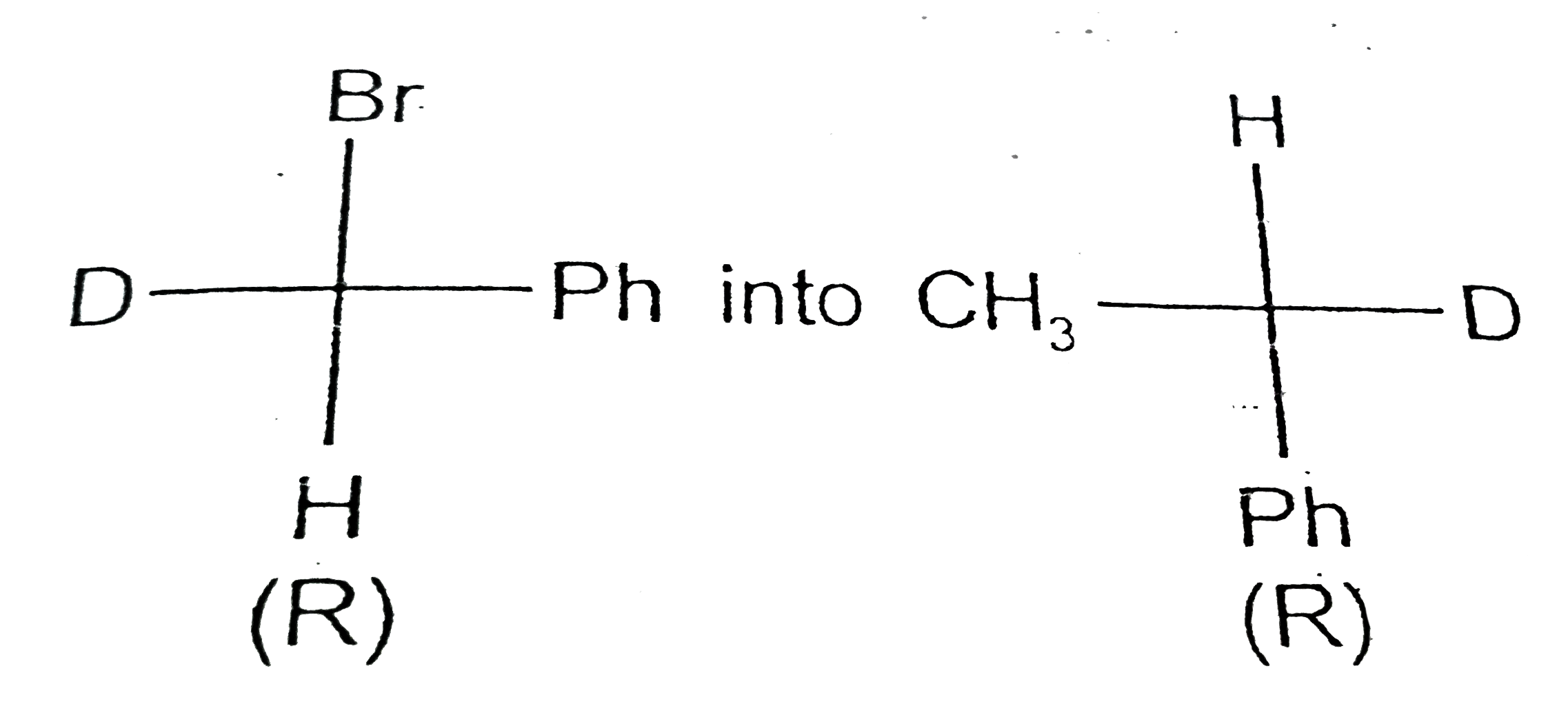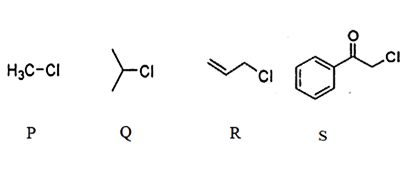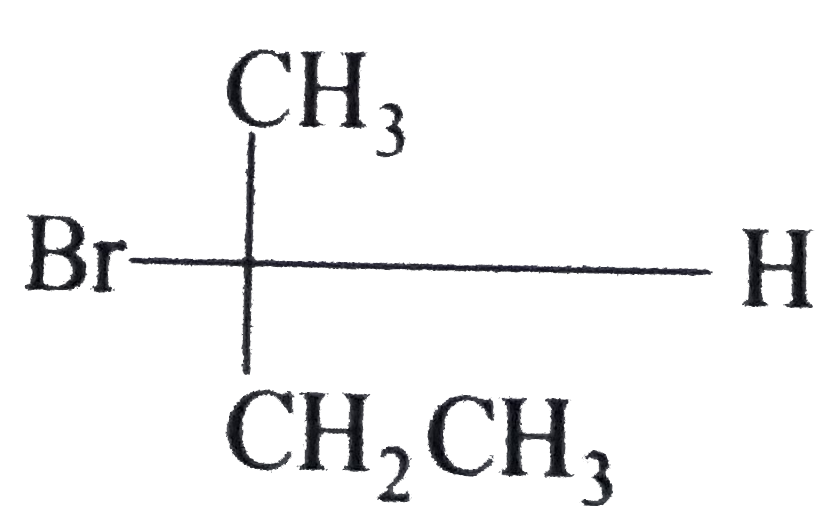Through SN2 reaction we cannot convert
CH3−CH2−CI into CH3CH2−CN
CH3−CH∣CH3−Br into
CH3−CH∣CH3−O−CH3∣C∣CH3−CH3
CH3−CH∣CH3−Br into
CH3−CH∣CH3−O−O∣∣C−CH3

The correct Answer is:2
To determine which compound cannot be converted through an SN2 reaction, we need to analyze each option provided in the question. The SN2 reaction is a bimolecular nucleophilic substitution reaction where a nucleophile attacks a carbon atom, leading to the displacement of a leaving group.
1. Option A: CH₃CH₂Cl to CH₃CH₂CN
- In this case, the nucleophile CN− can attack the carbon atom bonded to Cl in CH₃CH₂Cl.
- The Cl atom acts as a leaving group, and the reaction proceeds smoothly to form CH₃CH₂CN.
- Therefore, this conversion can occur via an SN2 reaction.
2. Option B: CH₃C(CH₃)CH₂Br to a bulky product
- Here, the structure indicates a tertiary carbon due to the bulky C(CH₃) group.
- The nucleophile (which is bulky, such as K+ with t−BuO−) will not effectively perform an SN2 reaction because it is a poor nucleophile due to steric hindrance.
- Instead, it will likely undergo an elimination reaction (E2) rather than substitution.
- Therefore, this conversion cannot occur via an SN2 reaction.
3. Option C: CH₃CHBrCH₃ to CH₃CHCH₃OC(=O)CH₃
- The nucleophile OCOCH₃− can attack the carbon bonded to Br.
- The Br will leave as a leaving group, allowing the formation of the desired product.
- This conversion can occur via an SN2 reaction.
4. Option D: A compound with bromine, phenyl, deuterium, and hydrogen
- The nucleophile CH₃− can attack the carbon bonded to Br.
- The Br will leave, allowing for the formation of a new compound.
- This conversion can also occur via an SN2 reaction.
Conclusion:
The only compound that cannot be converted through an SN2 reaction is Option B: CH₃C(CH₃)CH₂Br to the bulky product.
- In this case, the nucleophile CN− can attack the carbon atom bonded to Cl in CH₃CH₂Cl.
- The Cl atom acts as a leaving group, and the reaction proceeds smoothly to form CH₃CH₂CN.
- Therefore, this conversion can occur via an SN2 reaction.
- Here, the structure indicates a tertiary carbon due to the bulky C(CH₃) group.
- The nucleophile (which is bulky, such as K+ with t−BuO−) will not effectively perform an SN2 reaction because it is a poor nucleophile due to steric hindrance.
- Instead, it will likely undergo an elimination reaction (E2) rather than substitution.
- Therefore, this conversion cannot occur via an SN2 reaction.
- The nucleophile OCOCH₃− can attack the carbon bonded to Br.
- The Br will leave as a leaving group, allowing the formation of the desired product.
- This conversion can occur via an SN2 reaction.
- The nucleophile CH₃− can attack the carbon bonded to Br.
- The Br will leave, allowing for the formation of a new compound.
- This conversion can also occur via an SN2 reaction.
The only compound that cannot be converted through an SN2 reaction is Option B: CH₃C(CH₃)CH₂Br to the bulky product.
Topper's Solved these Questions
- HALOALKANES AND HALOARENES BOOK - AAKASH INSTITUTE ENGLISHCHAPTER - HALOALKANES AND HALOARENES EXERCISE - Assignment (Section - C ) ( Objective Type Question(More than one options are correct ))
17 Videos
- HALOALKANES AND HALOARENES BOOK - AAKASH INSTITUTE ENGLISHCHAPTER - HALOALKANES AND HALOARENES EXERCISE - Assignment (Section - D) (Linked Comprehension Type Question )
8 Videos
- HALOALKANES AND HALOARENES BOOK - AAKASH INSTITUTE ENGLISHCHAPTER - HALOALKANES AND HALOARENES EXERCISE - Assignment (Section - A ) ( Competition Level Question )
50 Videos
- GENERAL PRINCIPLES AND PROCESSES OF ISOLATION OF ELEMENTSBOOK - AAKASH INSTITUTE ENGLISHCHAPTER - GENERAL PRINCIPLES AND PROCESSES OF ISOLATION OF ELEMENTSEXERCISE - Try Yourself
33 Videos
- HYDROCARBONSBOOK - AAKASH INSTITUTE ENGLISHCHAPTER - HYDROCARBONSEXERCISE - Assignment(Section - C) (Previous Years Questions)
60 Videos
Similar Questions
Knowledge Check
Rate of SN1 reaction is :
 AS>Q>R>PBS>R>P>QCP>Q>R>SDS>R>Q>P
AS>Q>R>PBS>R>P>QCP>Q>R>SDS>R>Q>PSN1 reaction is fastest in
ACH3CH2BrBCH3−CH∣Cl−CH3CCH3−CH3C∣∣CH3−ClDCH3−CH∣CH2∣CH3−ClRate of SN2 reaction is :
 A(B)>(A)>(C)B(C)>(A)>(B)C(A)>(B)>(C)D(A)>(C)>(B)
A(B)>(A)>(C)B(C)>(A)>(B)C(A)>(B)>(C)D(A)>(C)>(B)
NGP (neighouring group of participation) assistance for SN2 reaction will not be seen in -
View SolutionKl in acetone , undergoes SN2 reaction with each of P,Q,R,and S The rates of the reaction vary as

View SolutionIn SN2 reactions the corect order of reactivity for the following compound :
View SolutionExplain why does a SN2 reaction involve an inversion in configuration.
View SolutionStatement -1 : Rate of SN1 reaction is faster than that of SN2 reaction
Statement -2 : SN2 reaction is favoured by polar aprotic solvent
Statement -3 : SN1 reaction involves racemization
View Solution


_S01_421_Q01.png)